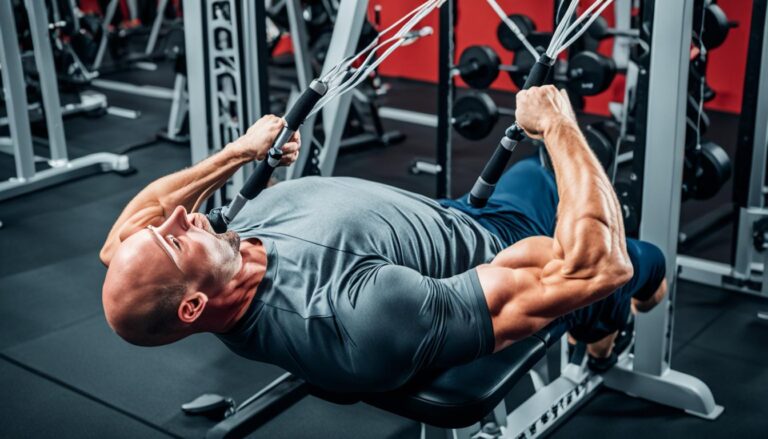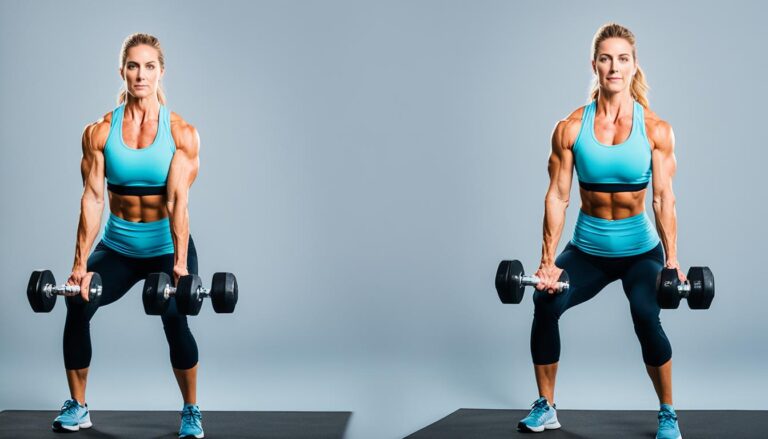In today’s fast-paced world, finding time to visit a gym can be challenging. That’s why many fitness enthusiasts are turning to at-home fitness to maintain their workout routines and achieve their fitness goals. One of the most effective methods to engage in cable resistance training at home is through the use of cable machines, which offer a versatile and efficient way to build muscle right in the comfort of your home.
This comprehensive guide aims to transform your home into a gym with effective and engaging home workout routines. From understanding the benefits of cable workouts to selecting the essential equipment, this guide will help you get started with a well-rounded workout plan. For those interested in targeting specific muscle groups, such as the back, you’ll find detailed exercises designed to maximize muscle engagement and growth. For more details on effective cable exercises, you can explore additional resources here.
Key Takeaways
- At-home fitness can save time and provide convenience.
- Cable resistance training is effective for building muscle.
- You can create a versatile workout routine using cable machines at home.
- Proper equipment and techniques are crucial for safety and efficacy.
- Targeted exercises can enhance muscle engagement and growth.
Benefits of Cable Workouts
Cable workouts present a unique array of benefits that can elevate your fitness routine. These exercises are instrumental in achieving muscle toning and strength gains, essential for functional fitness. The continuous tension offered by cable machines allows for targeted and effective workout sessions.
Improved Strength and Stability
Utilizing cable workouts leads to significant strength gains by engaging muscles throughout the full range of motion. The resistance provided by cables ensures that muscles are constantly under tension, promoting muscle toning and overall stability. This resistance is pivotal in enhancing functional fitness, enabling you to perform daily activities with greater ease and efficiency.
Versatility and Variety
One of the standout advantages of cable workouts is exercise versatility. Cable machines allow for a wide range of movements that target multiple muscle groups, keeping workouts fresh and engaging. This versatility means that you can adjust the equipment to perform different exercises without needing additional machinery. Whether you’re focusing on upper body, lower body, or a full body regimen, cable workouts offer the variety necessary to prevent workout monotony and promote consistent gains.
| Benefit | Description |
|---|---|
| Muscle Toning | Continuous tension helps define and tone muscles |
| Strength Gains | Engages muscles through full range of motion for improved strength |
| Functional Fitness | Improves your ability to perform everyday tasks with ease |
| Exercise Versatility | Allows for a variety of movements targeting different muscle groups |
Essential At-Home Gym Equipment
Creating an optimal home gym setup is crucial to achieving your fitness goals efficiently. Today, I will guide you through essential equipments that you’ll need for an effective workout experience. Let’s delve into the must-haves for any fitness enthusiast aiming for gym quality workouts at home.
Cable Machines
Investing in cable workout equipment can considerably elevate your home gym setup. Cable machines are versatile and reliable, offering a wide range of exercises that cater to various muscle groups. These machines are designed to maximize space without compromising on the breadth of workouts they provide.
- Compact cable systems
- Wall-mounted multifunctional units
- Adjustable pulleys for customizable settings
These machines enable smooth transitions between different exercises, supporting a seamless workout routine.
Accessories and Attachments
To further enhance the versatility of your cable workout equipment, investing in various accessories and attachments is vital. These tools not only diversify your exercises but also facilitate more customizable workout gear.
Here is a table of common accessories that can augment your home gym:
| Accessory | Function | Benefit |
|---|---|---|
| Tricep Rope | Isolates the triceps | Enhances arm strength |
| Lat Pulldown Bar | Targets the upper back | Builds upper body muscle |
| Ankle Straps | Aids in lower body workouts | Increases leg endurance |
By incorporating these attachments into your setup, you create a dynamic and efficient workout environment.
For more details on building a comprehensive home gym, you can explore efficient options and more on cable workout equipment through proven resources.
Cable Exercise Routines for Beginners
Starting with cable exercises can be an excellent way for beginners to build strength and improve overall fitness. These routines are designed to be simple yet effective, offering a balanced approach to training different muscle groups.
Warm-Up Exercises
Before diving into your beginner workouts, it’s crucial to incorporate proper warm-up routines. They help prepare your muscles and reduce the risk of injury. A good warm-up might include light cardio, stretching, and some initial cable exercises at a lower intensity.
- Light Cardio: Begin with 5-10 minutes of light cardio, such as jogging in place or jumping jacks, to get your heart rate up.
- Dynamic Stretching: Perform dynamic stretches targeting major muscle groups. Arm circles, leg swings, and torso twists are effective options.
- Low-Intensity Cable Exercises: Use your cable machine to perform gentle rows or chest presses to start engaging your muscles.
Full Body Workout
Once you’re warmed up, it’s time to move into a full body cable workout. This approach ensures all major muscle groups receive attention, promoting balanced development. For beginners, focusing on compound movements can maximize efficiency and results.
- Seated Cable Row: Sit at the cable machine and pull the handle towards your torso. This exercise targets your back and biceps effectively.
- Cable Squats: Stand with feet shoulder-width apart, holding the cable handle in front of you. Squat down, keeping your back straight, engaging the quadriceps and glutes.
- Cable Chest Press: Set the pulleys to chest level, grab the handles, and press forward. This move strengthens the chest and triceps.
- Lateral Cable Raises: Using a lower pulley, lift your arm to the side until it is shoulder height. This targets the shoulders.
- Standing Cable Crunch: Set the pulley above you, grab the handle, and crunch forward. This effectively works the abdominal muscles.
By integrating these basic cable exercises into your beginner workouts, you can build a strong foundation for more advanced training. Remember, consistency and proper form are key to maximizing the benefits of your workouts.
Advanced Cable Workouts
As you progress with your fitness journey, incorporating advanced cable exercises into your regime is essential for continuous muscle growth and development. One effective method to achieve this is through the principle of progressive overload. This involves incrementally increasing the resistance or intensity of your exercises to push your muscles beyond their usual limits, thereby stimulating further growth.
High-intensity workouts are particularly beneficial when aiming to enhance your fitness level. By integrating advanced cable exercises with high-intensity intervals, you can maximize your workout efficiency and burn more calories in less time. Exercises such as cable chest flyes, lat pulldowns, and seated rows can be intensified with shorter rest periods and higher repetitions.
- Increase Resistance: Gradually add more weight to your cable exercises to challenge your muscles and promote progressive overload.
- Optimize Tempo: Adjust the speed of your movements to create more tension on the muscles, leading to increased strength and endurance.
- Vary Exercises: Incorporate different cable exercises to target various muscle groups and prevent workout monotony.
An excellent resource for structured cable workouts is the Cable Builder program. This program offers a comprehensive guide for incorporating advanced cable exercises and high-intensity workouts into your routine, ensuring a well-rounded approach that adheres to the principle of progressive overload.
Remember to include proper rest days and focus on nutrient intake to support your rigorous training schedule. Active recovery, adequate sleep, and hydration are crucial elements that complement your high-intensity cable workouts, ultimately leading to better results and muscle growth.
Creating a Home Workout Plan
Establishing a home workout plan is a crucial step towards achieving your fitness aspirations. A well-structured plan, which includes personalized workout plans, ensures that your efforts are focused and productive. Here’s how you can create a successful home workout plan tailored to your needs.
Setting Goals
The first step in devising a home workout plan involves setting clear and attainable fitness goals. Consider what you aim to accomplish, be it weight loss, muscle gain, or overall fitness improvement. Clearly defined goals will guide your personalized workout plans and keep you motivated.
Choosing the Right Exercises
Once you have your goals set, the next phase is to focus on exercise selection. Opting for exercises that align with your fitness goals is essential. Cable workouts, for instance, can be a versatile choice. You can read more about the comparative benefits of cable workouts versus free weights here.
Tracking Progress
Monitoring your progress is vital to sustaining your fitness journey. Implement methods for workout tracking, like using fitness apps, keeping a workout journal, or using wearable technology. This not only helps you stay on course but also allows you to make necessary adjustments to your personalized workout plans as you advance.
By following these steps, you can create an effective home workout plan that keeps you dedicated to your fitness goals. Remember to stay consistent and adapt your plan as needed.
Incorporating Bodyweight Exercises
Integrating bodyweight training with cable workouts is a strategic way to enhance overall fitness. By combining these methodologies, you can achieve a balanced regimen that strengthens muscles, improves stability, and promotes functional strength. This approach ensures a well-rounded workout that leverages the benefits of both exercise forms.
Core Integration
Core integration exercises are essential for boosting stability and enhancing overall body coordination. By utilizing cable and core exercises, you engage the deep muscles of your abdomen and back, ensuring effective support for more complex movements. Planks, mountain climbers, and leg raises are excellent examples of exercises that can be advanced by incorporating cables.
Understanding the importance of core stability allows an individual to perform compound movements more effectively. Incorporating exercises that target the core with cables can dramatically improve balance and posture, which are crucial elements of functional strength.
Compound Movements
Compound movements are pivotal in enhancing functional strength and overall body coordination. By combining bodyweight exercises like push-ups, pull-ups, and squats with cable workouts, you can target multiple muscle groups simultaneously. This not only saves time but also maximizes muscle engagement, leading to more comprehensive strength development.
I emphasize the importance of incorporating a variety of exercises in your routine. For instance, pairing the versatility of cable machines with the simplicity of bodyweight training offers endless possibilities for variations that keep your workouts challenging and engaging. Adopting compound movements with a focus on functional strength transforms standard exercise routines into powerful, efficient training sessions.
For those interested in exploring different exercises that can be incorporated into their workouts, I recommend checking out this comprehensive guide on cable workouts to gain more insights into effective training techniques.
| Exercise | Main Muscles Used | Bodyweight or Cable |
|---|---|---|
| Planks | Core, Shoulders | Bodyweight |
| Mountain Climbers | Core, Legs | Bodyweight |
| Leg Raises | Lower Abs | Cable |
| Push-Ups | Chest, Triceps | Bodyweight |
| Straight Arm Pulldown | Lats, Triceps | Cable |
In conclusion, seamlessly integrating bodyweight training with cable exercises helps you maximize the benefits of both methods. By focusing on core integration and compound movements, you can build significant functional strength, improve stability, and create an engaging, effective exercise regimen.
Strength Training Techniques with Cable Machines
Mastering strength training with cable machines can elevate your resistance training workouts to new heights. The versatility of cable machine techniques allows for the customization and modification of traditional exercises, ensuring optimal muscle engagement and adaptation.
By integrating cable machines into your strength training regimen, you can effectively target different muscle groups while maintaining constant tension throughout each movement. Here are a few key techniques to consider:
- Adjustable Resistance: Cable machines offer various resistance levels, allowing for progressive overload and adaptation. Gradually increasing the weight enhances muscle growth and endurance.
- Range of Motion: Cable machines provide a full range of motion, which can be tailored to suit specific exercises. This comprehensive approach is crucial for balanced muscle development and reduced risk of injury.
- High Cable Pulls: This technique engages the upper body, particularly the shoulders and upper back, by pulling the cable from above your head down to your midsection.
- Low Cable Rows: Target the lower back and core by pulling the cable from a lower position up towards your torso, ensuring a firm grip and controlled motion.
Combining these cable machine techniques with other resistance training methods can lead to a comprehensive and effective strength training program. By embracing the principles of resistance training, you enhance muscle engagement and promote overall fitness.
Full Body Cable Workouts
Engaging in a total body exercise regimen ensures you build a balanced, strong physique. A comprehensive approach to cable workouts divides the focus between the upper and lower body, providing ample opportunities to target specific muscle groups efficiently.
Upper Body Focus
Upper body cable workouts are excellent for developing strength and stability in the arms, shoulders, chest, and back. Below is a list of effective exercises:
- Chest Press: Targets the pectoral muscles.
- Seated Cable Row: Engages the latissimus dorsi and rhomboids.
- Overhead Shoulder Press: Works on the deltoids and trapezius.
- Tricep Pushdowns: Focuses on the triceps.
- Bicep Curls: Strengthens the biceps.
Lower Body Focus
Lower body cable workouts help sculpt and fortify the legs and glutes. Here are some pivotal exercises:
- Squats: Activates the quadriceps, hamstrings, and glutes.
- Lunges: Targets the quadriceps, glutes, and calves.
- Leg Presses: Engages various leg muscles for overall strength.
- Hamstring Curls: Focuses on the hamstrings.
- Calf Raises: Strengthens the calves.
Consulting the table below can assist you in structuring your total body exercise plan efficiently:
| Exercise | Muscle Group | Recommended Reps | Sets |
|---|---|---|---|
| Chest Press | Pectorals | 10-12 | 3 |
| Seated Cable Row | Back (Lats and Rhomboids) | 10-12 | 3 |
| Overhead Shoulder Press | Shoulders (Deltoids and Trapezius) | 10-12 | 3 |
| Squats | Legs (Quadriceps, Hamstrings, Glutes) | 10-15 | 3 |
| Lunges | Legs (Quads, Glutes, Calves) | 10-15 | 3 |
Maintaining Fitness Motivation at Home
Keeping your workout motivation high while exercising at home can be challenging but rewarding. The key lies in designing a home gym environment that fosters enthusiasm and promotes fitness consistency.
Creating a Dedicated Space
Establishing a dedicated space for workouts is crucial for maintaining motivation. This area should be inviting, well-organized, and tailored to your fitness needs. Optimize your home gym environment by ensuring it is well-lit, ventilated, and stocked with essential equipment. Personal touches, such as motivational posters and a music system, can enhance your experience, making your workout space a place you look forward to using every day.
Staying Consistent
Staying consistent in your fitness routine is vital for progressing towards your goals. Implementing a structured workout schedule helps establish a routine, making it easier to stay committed. Tracking your progress and celebrating milestones not only keeps you motivated but also provides a tangible record of your achievements.
Consistency is supported by setting realistic goals and gradually increasing their complexity. Pairing up with a virtual workout buddy can also provide an extra layer of accountability and encouragement. Remember, maintaining fitness consistency is about finding ways to make your home workouts enjoyable and effective.
Conclusion
Throughout this Comprehensive Guide to Cable Workouts at Home, we have explored the multifaceted benefits and strategies of utilizing cable machines in your fitness journey. From the initial understanding of enhanced strength and stability to the versatility cable workouts offer, it’s evident that this approach can be a game-changer for achieving home workout success.
We’ve delved into the essential equipment needed, tailored exercise routines for various fitness levels, and advanced techniques to push your boundaries. The inclusion of bodyweight exercises alongside cable workouts ensures a holistic approach, promoting overall strength and functional fitness. Additionally, crafting a personalized workout plan and maintaining motivation through dedicated spaces and consistency play crucial roles in long-term success.
In summary, embracing cable workouts at home can significantly elevate your fitness journey. The adaptability and efficiency of cable machines make them an invaluable addition to any home gym setup. By prioritizing personalization and leveraging the insights shared in this guide, you’re well-positioned to achieve and sustain your fitness goals with ease.
FAQ
What are the benefits of incorporating cable workouts into my at-home fitness routine?
Cable workouts provide numerous benefits, including improved strength and stability, muscle toning, and enhanced functional fitness. The versatility and variety of exercises possible with cables mean you can target different muscle groups, keeping your routine fresh and challenging. Additionally, cable resistance training is effective for building muscle and can be easily adapted to your fitness level and goals.
What essential at-home gym equipment do I need for cable workouts?
To perform cable workouts at home, you’ll need a cable machine or a compact cable pulley system suitable for your space. Additionally, various accessories and attachments such as handles, ankle straps, and bars can enhance your workouts by providing more exercise options and greater customization.
I’m new to cable workouts. Can you suggest some beginner-friendly routines?
Absolutely! Start with a warm-up to prepare your muscles and prevent injuries. Then, you can follow a simple full-body cable workout that includes exercises like cable squats, chest presses, seated rows, and triceps pushdowns. These beginner routines will help you get familiar with using the cables and progressively build your strength.
How can I intensify my cable workouts if I am looking for something more advanced?
For more advanced cable workouts, you can incorporate high-intensity exercises and the principle of progressive overload. This involves gradually increasing the weight or resistance, adding more sets and reps, and incorporating complex movements like cable lunges with rows or single-arm chest presses to continually challenge your muscles and stimulate growth.
What strategies can help me create a successful home workout plan?
Creating a successful home workout plan involves setting realistic and achievable fitness goals, selecting the right cable exercises to meet those goals, and tracking your progress. A personalized plan tailored to your needs and fitness level will keep you motivated and on track to see tangible results over time.
How can I combine bodyweight exercises with cable workouts for a comprehensive fitness routine?
Combining bodyweight exercises with cable workouts can enhance overall fitness. You can incorporate core integration exercises such as planks or mountain climbers with cable exercises to enhance stability. Additionally, compound movements like cable squats with bicep curls can promote functional strength and coordination, providing a well-rounded workout regimen.
What specific techniques can I use with cable machines for effective strength training?
Effective strength training with cable machines involves understanding resistance training principles. Use various resistance levels to maximize muscle engagement. Incorporate traditional strength training exercises like cable deadlifts or lat pulldowns and modify them to increase resistance and challenge your muscles further. Focus on controlled movements and proper form to maximize the benefits.
Can you provide examples of full-body cable workouts with upper and lower body focus?
Sure! A full-body cable workout can be divided into upper and lower body focus sessions. For the upper body, exercises like cable chest presses, lat pulldowns, and triceps extensions can be effective. For the lower body, try cable squats, lunges, and leg curls. This approach targets all major muscle groups, ensuring a balanced total body exercise regimen.
How can I maintain my fitness motivation while working out at home?
Maintaining fitness motivation at home can be challenging, but creating a dedicated workout space can help. Ensure it’s inviting and well-equipped to encourage regular exercise. Staying consistent with your workouts by setting routine schedules, tracking progress, and implementing self-reward systems for milestones achieved can also enhance motivation and drive.






